Menus
- transformation
- "I’m not exactly a skilled craftsman"
- 120 kilos dry weight
- Aluminum fittings of a 250cc Suzuki
- Sunday Ride Classic in spring 2016
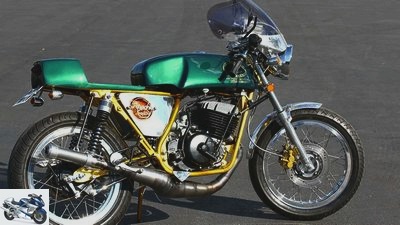
Blacksmith
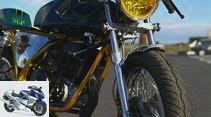
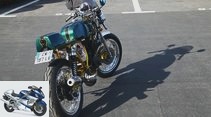

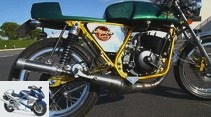
15th photos
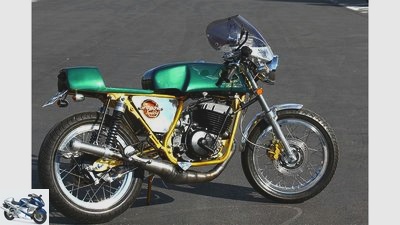
Blacksmith
1/15
It’s hard to believe that this once was a completely rotten 400cc Suzuki enduro. The French Henri Mahe breathed life back into her with a lot of esprit, enthusiasm and passion. And completely transformed the two-stroke engine.

Blacksmith
2/15
Fits perfectly: classic yellow lamp, as it should be on a French motorcycle.

Blacksmith
3/15
The fine leather seat was still with the saddler and was added later.
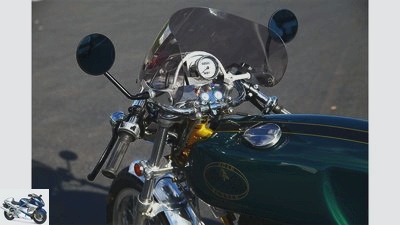
Blacksmith
4/15
Aluminum fittings of a 250cc Suzuki from 1969 are screwed to the narrow M handlebar.
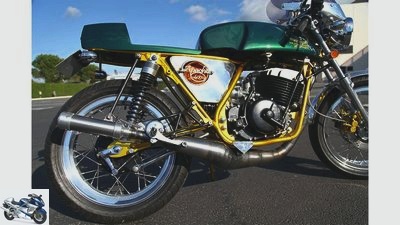
Blacksmith
5/15
The thin silencer and bracket were made of aluminum, the rest of the two-stroke exhaust, namely the manifold and bulb, was provided by a specialist from central France, who punched out, rolled and then neatly welded metal sheets.

Blacksmith
6/15
The footrests are custom-made and the position can be easily adjusted.
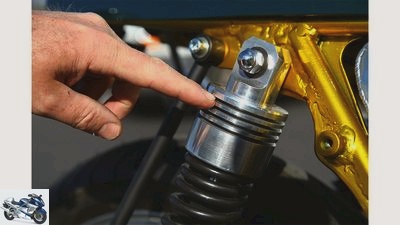
Blacksmith
7/15
The attention to detail can be seen everywhere: The sleeves for the struts are turned and milled out themselves.
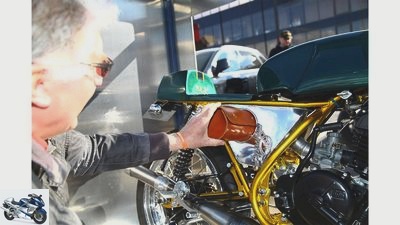
Blacksmith
8/15
… Access to the tool is already open. Let’s hope that this isn’t necessary too often.
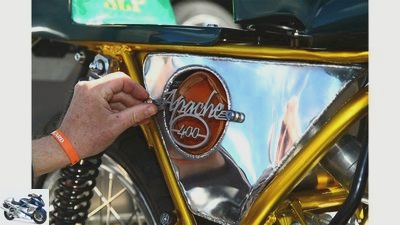
Blacksmith
9/15
… the leather tool bag. Just hang up the logo and …
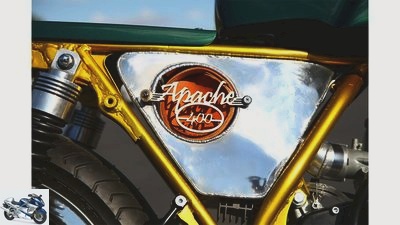
Blacksmith
10/15
French chic, inspired by the States: behind the lasered logo rests frivolously …
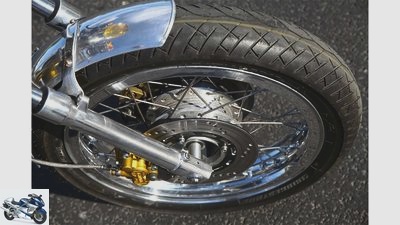
Blacksmith
11/15
Noble: polished dip tubes, wheel hub milled from solid and gold-anodized brake caliper.
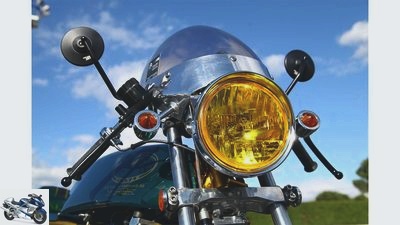
Blacksmith
12/15
… in green-gold-black and designed as a single seater.
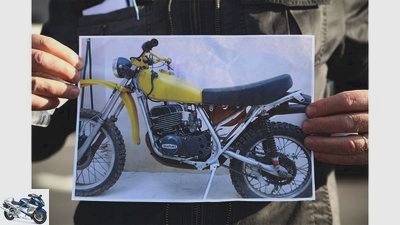
Blacksmith
13/15
An enduro turned into a cafe racer, very stylish …
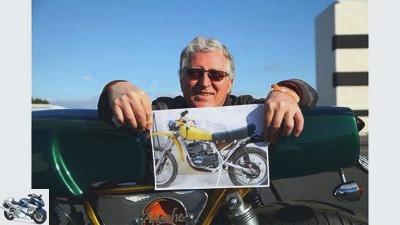
Blacksmith
14/15
The effort involved in converting it into a Cafe Racer was enormous, but the novelist now has a new main character. What a metamorphosis. Not only has the color changed, but the entire geometry.
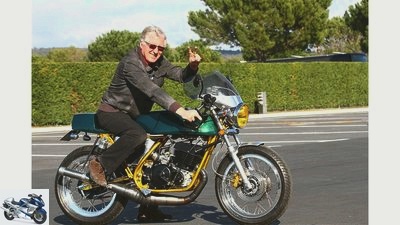
Blacksmith
15/15
Have a good laugh: The ex-diplomat is happy about (s) a unique, distinctive Suzuki conversion.
Self-made cafe racer based on Suzuki TS 400
transformation
Content of
Henri Mahe breathed life back into a completely rotten Suzuki TS 400 from 1977. The conversion to a Cafe Racer was enormous, but the novelist now has a new main character.
E.t is a perfect Provencal spring day that enchants me on this Easter Sunday in Le Castellet. Plenty of sun, plus a warm wind that blows the concert from hundreds of exhausts directly into my cilia. Around 500 classics, racing and sports machines, do their laps at the Circuit Paul Ricard in races and demo drives in different classes. Including 14 ex-champions who not only give autographs, but also show their driving skills. It all reminds me of the Bikers’ Classics in Spa-Francorchamps. It’s just a little cheekier, more frivolous, more French.
Buy complete article
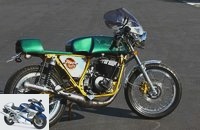
Self-made Cafe Racer based on Suzuki TS 400
transformation
Suzuki TS 400 from 1977 as the basis
“This is my very special road machine,” says Monsieur Mahe, “it was only finished two days ago.” So please excuse the fact that the leather seat is still with the saddler. What was the basis of this cafe racer? “A Suzuki TS 400 from 1977.” A TS? That was the Enduro, built from 1971 to 1979, with 34 hp, with studded tires (19 inch front, 18 inch rear), kick starter and characteristic kink in the raised silencer. “Yes, just imagine, the single stood there for ten years, forgotten in the miserable corner of a garden in the country.” Henri shows me a photo of the 400 series shortly before its final decay.
An advertisement put the 58-year-old on the trail of the yolk-yellow Suzuki. “She spontaneously awakened my pity.” The aged enduro stood outside completely unprotected. “Plants were already growing right through the middle,” recalls Henri, “Chickens used the Suzuki as a lookout point. I had to do something. ”At that time, Henri had no idea that two years of work awaited him and his helpers – every Friday evening they met after the job and worked the whole night through. Henri Mahe worked for the French Foreign Ministry until 2005. He then hired himself out as an author; his fourth novel entitled “Le Certificat” has just been published.
"I’m not exactly a skilled craftsman"
But how did the complete conversion of the 400 come about? “I didn’t want to rebuild the motorcycle as it was, but to make something new out of it, something unique using the frame and engine of the Suzuki TS 400.” The only problem with that: “I’m not exactly a gifted craftsman.” So I had to Partner, a mentor. Henri found it after reading magazine articles in Emmanuel Olivier, the head of the MG Moteurs company from La Farlède. “Emmanuel is a super mechanic, a craftsman par excellence, specializing in the procurement and manufacture of parts, but also in complete restorations.”
Emmanuel Olivier turned and milled the wheel hubs from four kilogram aluminum blocks. In total, he even needed over ten kilograms of aluminum: “We had to make a number of special parts, such as our own fork bridges.” This contains the fork legs of a Honda NSR 125. The frame was shortened and the rear was adapted. Emmanuel also made a thin muffler and holder. The rest of the two-stroke exhaust, namely the manifold and the bulb, was provided by a specialist from central France, who punched out, rolled and then neatly welded metal sheets. The artistically assembled exhaust devoured around 30 hours of work.
120 kilos dry weight
However, the welder’s masterpiece is the trapezoidal, highly polished air filter box with the circular cut-out in the middle, which houses the leather tool bag. Or is it the make-up bag for the woman? “No!” Henri decided on a single-seater, which he named “Apache 400”, as a reminiscence of the former model name of the Suzuki Enduro in the USA. “I also like the North American natives.”
Henri Mahe learned a lot from Emmanuel Olivier. This also took over the urgently needed revision of the single cylinder. The engine had to be completely overhauled and re-stored, and the surfaces had to be blasted. After around ten years outside in wind and weather, even the piston in the cylinder was rusted. Stupid because there were no longer any original Suzuki pistons. But Henri was lucky: “A piston from a 700 twin from Polaris, which otherwise drives jet skis, was the perfect fit.” The builder duo aimed for around 45 hp for the 400 single: “We have adapted a new carburetor really well. “A dry weight of 120 kilos makes the petite noble Suzuki look extremely light when maneuvering, almost like a bicycle.
Aluminum fittings of a 250cc Suzuki
Titanium screws and a feather-light lithium-ion battery under the long 12-liter polyester tank, which swallows a mixture in a ratio of 1:20, made it easier to slim down. The instrument panel is also handcrafted, as is the toggle switch for the ignition. Aluminum fittings of a 250cc Suzuki from 1969 are screwed to the narrow M handlebar. The footpegs are custom-made, but Henri himself cut the shiny support for the curved windshield by hand. So many fine details, so much work …
The parts and blanks alone cost around 8,000 euros. The yellow lens in the chrome headlights was cheaper, it comes from a French car from the 1970s. In addition to the footrests, MG Moteurs also milled the distributor for the steel braided lines to the front double disc brake with two-piston floating calipers from Grimeca. Bridgestone BT 45s with good grip in the dimensions 110 / 80-18 and 140 / 70-18 are mounted on the Spanish Akront high-shoulder rims (2.50 x 18 and 3.00 x 18).
Sunday Ride Classic in spring 2016
The paintwork turned out to be very elegant: the wide black vertical stripes above the hump and tank are flanked by hand-drawn golden decorative lines on the left and right. A dream in green-gold-black, set off with a little chrome and aluminum sheen. The logo on the tank has an artistic effect: “Road Runner” can be read there, and “H.B. Original Motorcycle Ltd. “- the initials of the two first names of Monsieur Mahe: Henri Bernard. He reports of the great moment when the engine ran again for the first time after two years of work: “That was very moving, that barking sound!” Later, on the phone, Henri enthusiastically told me about trips on his 400, during which he had a 750 Kawasaki H2 could keep a good distance! “That really feels like a good 45 hp.”
In the diplomatic service Henri once had no time to ride a motorcycle, not even in Japan, where he worked in Osaka from 2001 to 2005. “That was a very interesting time, I got to know and appreciate Japanese culture.” He didn’t get back on the motorcycle until 2010, with a Benelli 254. In his youth, Henri drove 125cc from CZ and Honda, a 450cc Honda and later a 750cc -Suzukis, water buffalo and four-stroke GS. Today he keeps the afternoons free to ride his motorcycle, writing his novel early in the morning.
What remains is a simple insight: the French have a good taste in motorcycles. You can see for yourself at the next Sunday Ride Classic in spring 2016 (April 16 + 17). Henri Mahe also wants to be there again. Have a good trip, bonne route, with your Apache 400!
Related articles
-
Triumph Trident Cafe Racer reader conversion
Thomas Grad 10 pictures Thomas Grad 1/10 Triumph Trident Cafe Racer Thomas Grad 2/10 The handlebar fittings milled from aluminum by Motogadget look great …
-
Driving report Voxan Cafe Racer (2000)
Driving report Voxan Cafe Racer (2000) Avec Sucre It shouldn’t be too long before the French motorcycle manufacturer Voxan also wants to sweeten the…
-
Ducati Scrambler Cafe Racer driving report
Ducati 20 pictures Ducati 1/20 Ducati Scrambler Cafe Racer Ducati 2/20 Ducati Scrambler Cafe Racer Ducati 3/20 Historical quotes everywhere. The number…
-
Comparison test Aprilia SL 1000 Falco, Ducati ST 4S, Honda VTR 1000 F, Voxan Cafe Racer
Gargolov comparison test Aprilia SL 1000 Falco, Ducati ST 4S, Honda VTR 1000 F, Voxan Cafe Racer Sympathy-hunter Dull, but subtle thunder, …
-
On the move: Honda CB 750 Cafe Racer
Jahn 13 photos Jahn 1/13 Owner Peter Wolf can rightly be happy about his cream piece. Jahn 2/13 Two generations of Honda: Honda CB 750 Cafe Racer and…
-
Amphibious self-made Toledo Seascoot: Suzuki Burgman wreaks
facebook.com/toledoseascoot 8th photos facebook.com/toledoseascoot 1/8 Take an old jet ski and a first-generation Suzuki Burgman….
-
Gargolov Top test Voxan Cafe Racer What you want The booming V-Twin as a magnificent eye-catcher between the wheels, curves and shapes in the purest…
-
Gargolov 9 photos Gargolov 1/9 Louis spokesman and motorcycle fanatic Kay Blanke, mastermind behind the NX project. Gargolov 2/9 A cheeky cafe racer who…
-
Artist Test Benelli TnT Cafe Racer Gloss number It is not all gold that glitters, as the saying goes. Benelli’s new Cafe Racer is a brilliant success?…
-
Driving report Voxan Cafe Racer
Driving report Voxan Cafe Racer coffee machine Unadulterated two-cylinder aroma for pulse-accelerating enjoyment: The Cafe Racer from Voxan does its…